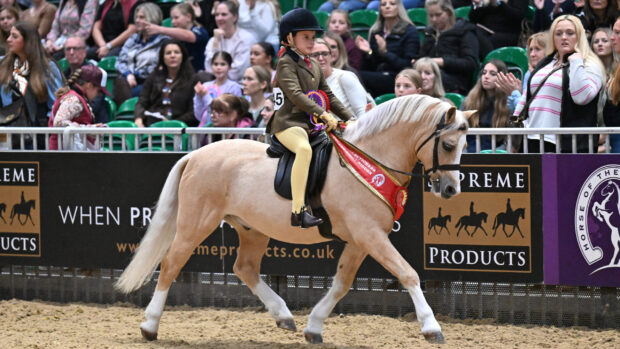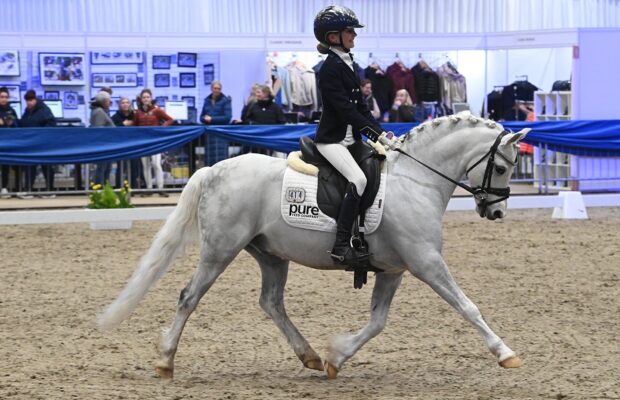Stylish, sociable and with enthusiasm in spades, the British Spotted Pony is a breed who’ll give anything a go. With a variety of heights, builds and spotty patterns across the breed standard, no two look the same. Their willing, trainable natures combined with their strength and agility makes them the perfect child’s pony, though they can be found thriving in all manner of settings.
Jump to: History at a glance | Breed standard | Conformation | Colouring | Uses
About the British Spotted Pony: history at a glance
There’s evidence of ponies sporting spotted coats in Europe stretching back to the Stone Age, according to spotted horse paintings found in the cave of Pech Merle, France. This, plus DNA samples from the period indicating the possibility of dappled patterning on equine coats, proves that spotted horses roamed Europe as many as 25,000 years ago.
As France and Great Britain were part of one land mass at this time, it’s not impossible that spotted ponies migrated across and established populations here.
Further evidence of spotted ponies in Europe can be found in medieval manuscripts and tapestries spanning Europe from Spain to Turkey. On home soil, a record from the year 1298 states that Edward I of England had a spotted Welsh horse. It is also said that Charles II rode a white horse with irregular red markings whose name was ‘Bloody Buttocks’.
Spotted horses and ponies were formalised as a British breed in 1946 with the formation of the British Spotted Horse and Pony Society. As spotted ponies became more and more scarce throughout the 1960s and 70s due to export overseas, the society split in 1976 to form the British Appaloosa Society and the British Spotted Pony Society. Since then, society has kept a detailed register composed of multiple sections to reflect the numerous classifications of the British Spotted Pony.
Breed standard
The British Spotted Pony varies in height from 8–14.2hh, and the society recognises three distinct types:
- miniature (42in/10.2hh or less)
- riding pony (up to 14.2hh)
- cob type (up to 14.2hh)
All types of British Spotted Pony must display some or all of the following:
- White sclera around the eye – this is a white outer layer of the eyeball and gives the eye a ‘human’ appearance
- Mottled skin – skin that is flecked part pink, part dark and is most visible in areas such as the muzzle, eyes and genitals
- Striped hooves
Conformation
Head: well-proportioned with a flat, wide forehead and large, expressive eyes. The head should feature prominent nostrils and the throat should be well-defined
Body: compact and muscular with a short, strong back, deep chest and sloping shoulders
Legs: square, clean and true. The forelegs should be long in the forearm with strong knees. The hindlegs should feature a hock well let down, the point of which should not be set behind the line from the point of the quarter to the fetlock. The cob type should have plenty of bone and may have feather
Mane and tail: Both should be thick and abundant with the tail well set on the quarters

A British spotted pony rests on Wolvercote Common.
Colouring
The breed society does not accept piebald or skewbald markings of any kind. However, permissible coat patterns range widely:
Leopard: spots of any colour on a white or light coat
Near leopard: as leopard, but with a darker head and/or legs
Few spot leopard: as leopard, but only very few spots
Snowflake: white spots on a dark overall coat
Blanket: an area of white colouring over the pony’s hindquarters, with or without spotting, on any overall coat colour. The “blanket” can extend over the back
Mottled: a coat irregularly flecked with white and that may feature roan spots of any size, which are often coloured with dark blots
Solid colour ponies with proven British Spotted Pony genetics are also accepted onto the appropriate register by the society. The society also notes that solid colour ponies can “spot out”, or develop a spotted pattern as described above, as they age. Such ponies will switch to the appropriate section of the register.
Uses
Thanks to their trainability, athleticism and high spirits, British Spotted Ponies of the riding pony and cob varieties can make excellent children’s Pony Club mounts. They can be seen in all areas of pony sport, from gymkhana games and pony racing to pony trials, showjumping and dressage. Their strength and sturdiness also make them highly suited to driving.
Britsh Spotted Ponies’ eye-catching coats suit them to in-hand and ridden showing classes. Many miniatures find their wheelhouse as in-hand show or lead-rein ponies, while others thrive as much-loved companions and pets.
- To stay up to date with all the breaking news throughout Pau Horse Trials, London International and more, subscribe to the Horse & Hound website
You may also be interested in:

How to spot an appaloosa, the colourful horse with prehistoric roots

What to consider if you’re hoping to buy a New Forest pony to enjoy or compete

The Exmoor pony: Britain’s oldest native breed
Find out everything you need to know about this native breed

Subscribe to Horse & Hound magazine today – and enjoy unlimited website access all year round





